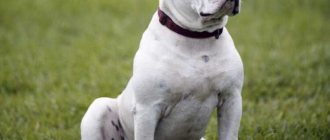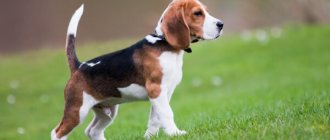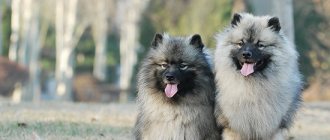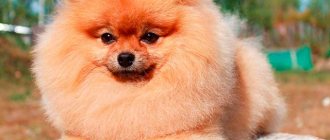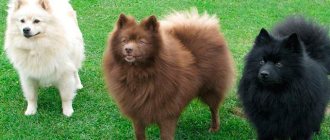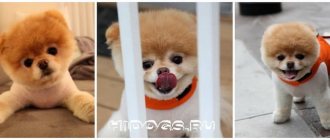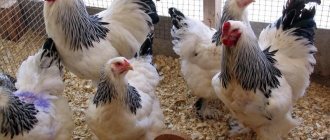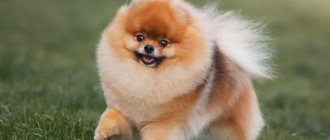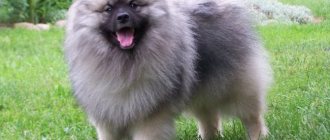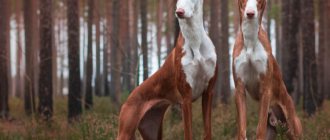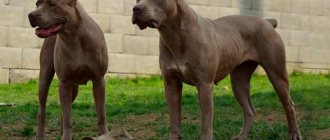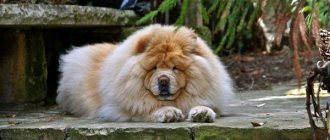The American Eskimo Spitz is a dog, at the sight of which any person with a good imagination will immediately imagine a sparkling snowy winter, snowdrifts and other attributes of this fabulous time of year. What fuels the fantasy is nothing other than the appearance of the animal we are talking about. However, in addition to their spectacular appearance, these dogs have many more advantages. Of course, they are not without their shortcomings. We will tell you about all the features of this dog in this article.
American Eskimo Spitz
History of the origin of the breed
Breeders' opinions on the origin of the breed differ somewhat. According to the official version, the American Eskimo Spitz was selected in North America at the beginning of the last century. Dog handlers believe that Samoyed huskies, which were brought overseas in 1913 along with the Greater German Spitz, were used in breeding the dogs. Dogs were brought to the continent by emigrants from Austria and Germany. Americans love funny pets.
Initially, Spitz dogs were bred to guard residential buildings and industrial facilities. In the Middle Ages, “bells” were widespread in Finland, Germany, and Pomerania. The dogs had fine hearing and pronounced territoriality. They barked loudly at strangers without being overly aggressive.
Dog breed Eurasier
After the end of the First World War, Esques gained new popularity - they began to be actively used in circus performances. The first dog show was created by the Cooper brothers in 1917. Under the name "American Eskimo Dog" the pets were registered in 1919 by the American Club.
Why these dogs began to be called that is not known for certain. They have nothing to do with the breeds of northern peoples. Perhaps the name appeared against the backdrop of growing patriotic sentiments and the denial of everything German. Some dog experts believe that this became a regular advertising stunt that “worked” - Eske’s popularity grew.
Such a dog is an adornment to its owner
After World War II, interest in the breed continued. The Japanese variety of Spitz was brought to the USA and they began crossing them with local individuals. The breeders focused on the white color of the dogs (this coat color was not welcomed in Germany).
The first documented description of Eske appeared in 1958 in the American Eskimo Spitz Club of America. At first the name applied to all dogs that were similar in appearance.
In 1970, the North American Eskimo Spitz Association finally identified the breed. The dogs' path to official recognition began in 1985. Only 10 years later (in 1995) the Association achieved recognition of the breed by the American Canine Federation.
The world professional community has not yet officially recognized the breed. For example, to participate in European shows, owners are forced to register “Americans” as German Spitz dogs. Germans give their dogs the blood of their overseas brothers to strengthen the gene pool.
American Eskimo Spitz: history, standard, appearance and character
Before we begin to study the external features and behavioral characteristics of the American Eskimo Spitz, we would like to tell you about how this breed as a whole came into being.
Origin story
The history of this breed is very interesting, despite the fact that relative to other breeds it began quite recently. The ancestor of the American Eskimo Spitz is considered to be a German representative of a similar breed of dog. In addition, there is a theory that another ancestor of these dogs were Samoyed huskies. In fact, a breeding selection of Spitz dogs of the appropriate snow-white color was simply carried out.
German Spitz are the predecessors of the American dog of the same name.
The country where the breed we are interested in was bred is America. As you may have noticed, many exotic breeds were developed in this country. The fact is that American breeders working with dogs often set themselves the goal of improving the breed qualities of one or another variety of these animals, which can be:
- external;
- physical;
- behavioral, etc.
In 1935, German Spitz dogs were brought to America for the first time. Their price at that time was considered fabulous. It was determined by:
- rarity of the dog;
- charming appearance of the animal;
- the disposition of these dogs towards humans.
The homeland of this breed of dogs is America.
Why, given that only their German ancestor is present in the genotype of the white fluffy Spitz, are they called American? Here's the thing. From the moment of the first appearance of this breed until the beginning of World War II, work was already underway to breed a snow-white representative of the breed. After the overthrow of the Third Reich, a clear anti-German sentiment remained throughout the world. In view of this circumstance, all Spitz living in America, which by that time had already been bred by local dog handlers, were named in honor of their new homeland.
Further work on breeding dogs of the breed we are interested in continued in the post-war period. Already in 1969, a whole community of residents of the American north was formed, who declared themselves lovers of the breed. Then in 1985, in order for the breed to receive recognition from the American Kennel Club, the country's first dog club for this breed was organized.
In 1995, namely from the first day of summer, this breed was included in the register as pure and existing separately from its German ancestor
Breed standard
A breed standard is a designation used to describe the external characteristics of a particular breed of dog. In essence, this is a certain set of parameters that the dogs in question correspond to, provided that they are pure representatives of the breed. Let's look at them in order.
Height and weight
So, according to the data currently available about this breed, there are several varieties of American Eskimo Spitz, namely three. The differences between each of them are only in greater or lesser height, as well as weight.
Obvious external differences between representatives of several varieties of the same breed
Table 1. Varieties of the American Eskimo Spitz
| Toy | Miniature | Standard |
So, since “toy” translated from English means the word “toy”, this name refers to the smallest representatives of the breed:
| Miniature representatives of the breed are slightly larger in size than their smaller counterparts. Thus:
| These are the largest of all:
|
Not every breed has such serious differences in height and weight. However, such a run adds to these dogs much greater popularity and even marketability, since:
- you can get the desired snow-white fluffy;
- preserve all its exterior and character parameters;
- At the same time, you will be able to determine the size of the animal that is suitable for you at the current time.
American Spitz puppy
So, for example, you can fit both decorativeness and “seriousness” into one dog: a dog of 16 kilograms is already considered an average breed, but he is still as beautiful as his brothers.
Head shape
You've probably heard more than once that breed lovers compare their pets to foxes. The thing is that the muzzle of these dogs really resembles a fox in shape:
- it is narrow;
- elongated;
- expanding directly adjacent to the skull.
As for the head as a whole, the size of these dogs is small, rounded and narrowed.
The face of the American Spitz resembles a fox
Coat
It is the wool that is the main pride of the American Eskimo Spitz, since they have it:
- very fluffy;
- volumetric;
- thick;
- soft;
- snow-white.
Interestingly, the fur, despite its color, gives this dog an even more “foxy” appearance.
Wool is the main pride of dogs of this breed.
Features of the Eskimo Spitz coat include:
- effective heat retention;
- moisture resistance.
Both of these qualities justify the ability of these seemingly decorative dogs to cope well with weather changes, low temperatures and other circumstances related to the environment.
As for colors, they can actually vary. So, in addition to snow-white, the following are allowed:
- cream;
- biscuit.
Dog fur color can vary
The main condition is that the color must be solid. Spots are not allowed, puppies born with them are considered a defect of the breed and do not participate in further breeding.
In the area of the chest, neck and ears, the fur forms a “collar”, as if additionally worn around the pet’s neck. This is the main decoration of the pet, and at the same time its weak point, since in the collar area there is often:
- tangles form;
- grasses and thorns get entangled, etc.
Character
Character is another breed parameter, and not a dog’s behavior randomly determined by nature. Despite the fact that the animal's personality will in any case be unique, the specific parameters of behavior are similar for each representative of the breed we are considering.
It must be said that the American Eskimo Spitz is an extremely popular dog among:
- beginners;
- experienced dog breeders.
It's all about their two main characteristics:
- good character;
- obedience.
According to statistics, American Spitz initially accept commands from humans much more readily than even their German ancestors.
The American Spitz is a brave and independent dog, and also very active.
However, this breed is represented by independent and brave dogs that will strictly follow their decision, sometimes even trying to ignore the attitude of their own owner. One can also say that these animals are really smart; for them, despite a certain degree of decorativeness of the breed, it is not typical for them to be Pugies from Krylov’s fable. However, in this case, the fluffies will respond with a bark to every word you say in their direction, and you will have to get used to this or explain to the dog that you are a lover of monologues.
Another extremely important point added to the positive qualities of the American Eskimo Spitz is the absence of aggression. In principle, it is not typical for this type of dog, especially for snow-white Spitz. That is why they are often chosen as a family dog, since this dog’s attitude towards children can be rated 10 out of 10 points:
- careful;
- attentive;
- tender;
- soaked in love.
This dog can be an excellent nanny, but it is important to remember that the child must behave carefully with it
If you have a child and a dog of this breed, you will often see the sweetest hugs of your pet and offspring. This dog copes well with the role of a nanny.
Due to the fact that these dogs are highly trainable, they often become participants in various:
- exhibitions;
- competitions;
- competitions, etc.
As for the activity of the white Eskimo Spitz, it is at their level, and it does not matter which particular variety of this breed we are talking about:
- Toy Spitz;
- miniature;
- standard
Exhibition standards
Since Eskes are not recognized by the Fédération Cynologique Internationale, there is no generally accepted breed standard for them. Dogs are judged on characteristics recorded by the American Kennel Club.
A purebred "Eskimo" must meet the following descriptions:
- the head is round, medium in size;
- the muzzle is dry, the lines of the eye sockets and cheekbones are covered with hair;
- lips are dark and fit tightly to the gums;
- scissor bite;
- nose is black;
- The eyes are medium-sized, oval, often dark brown or black. Let's say blue or different irises;
- the ears are triangular, erect, slightly rounded at the tips;
- the tail in a calm state curls into a semi- or full ring;
- limbs are straight and strong.
The body of the American Spitz is powerful, rectangular in shape, with a muscular back, and a chest of medium depth.
If your dog has all the necessary documents, including a pedigree, you can take part in exhibitions. To do this, study the exhibition schedule for 2022.
Exhibitions with CAC rank awards for 2022.
He's clearly in his element
Content Features
He idolizes the owner and considers himself a member of his family, therefore it is strictly forbidden to place the dog in a separate room behind a closed door.
It is advisable to equip him with his own space, a kind of “house” from where he will see everything that is happening with the household. Suitable for living both in an apartment and in rural areas.
Description, colors
At first glance, Eske give the impression of an elegant, medium-sized, harmoniously built dog with well-developed muscles.
The American's gait is smooth. The pet always maintains some alertness and interest in the events happening around it.
The color is recognized only as pure white, a pale beige shade is acceptable. The double coat of dogs consists of a dense, short undercoat and long axial hair. The latter should be straight, without creases or waviness. On the neck, chest, and hind legs the hair is slightly longer than on the rest of the body. The pile forms a voluminous “collar” and “pants”.
Disqualifying faults
Any deviation from the breed standard is considered a fault. A comprehensive assessment takes into account the severity of the deviation and its impact on the general condition of the dog. Esques with a flattened skull, beige eyelids or nose, and bulging eyes will not become show champions.
Disqualifying faults include:
- malocclusion;
- open fontanel;
- not fully erect ears;
- ectropy (or entropy);
- undescended testicles into the scrotum;
- obvious physical defects.
Warning! Cowardly, angry, and nervous Spitz dogs must be excluded from breeding.
For the American Eskimo, a defect is the presence of spots in the coat, any coat color other than white or beige.
Lifespan
Esques live to be 15 years old on average. In order for the dog to remain vigorous and active for many years, the owner must monitor his health.
Vaccinations protect your pet from deadly infections. Puppies undergo their first vaccination while still at the breeder, at two months of age. Babies are administered a complex drug, including deactivated strains:
- parainfluenza;
- plague;
- hepatitis A;
- enteritis;
- leptospirosis.
At 7 months, revaccination is carried out and protection against rabies is added. To maintain stable immunity, vaccinations must be done annually.
Warning! It is permissible to vaccinate only a dog that is absolutely healthy in all respects!
Before each procedure, the dog is dewormed and treated for fleas. Your pet must be vaccinated at a veterinary clinic. Most animals tolerate the drugs well; in the first two days, lethargy and decreased appetite are observed.
On a walk
Reviews from dog breeders about the breed
Michelle. A very beautiful dog with dazzling white fur. A ringing voice, a true protector, will not let anyone close to the owner. He loves our little son very much and does not leave his side. Plays and guards like a real nanny.
Catherine. My Spitz had dazzling blue eyes. I say there were because he became blind at the age of four. A very kind and affectionate dog, loves children. Obedient, he got used to commands in just a month.
Alevtina. It's charm itself. Beauty is combined with amazing intelligence. My Spitz is a terrible neat guy - if the bedding gets a little dirty, he will never lie down. There is always perfect order around the bowl, he eats very neatly. He wears a diaper and has never taken a shit anywhere. During walks he always runs around, sniffing everything. The dog is easy to care for, but you should not leave it alone for a long time. If I’m late from work, he gets offended and may even bite my leg.
It will be interesting to watch a program about American Eskimo Spitz dogs, we wish you pleasant viewing.
Care
Like the Kleinspitz, the American Eskimo Spitz is suitable for both apartment and kennel keeping (in regions with a warm climate), but it is important to consider that dogs do not feel well alone. If the pet is the only one, it is better to assign it a place to live in close proximity to its owners.
The bed should be prepared in advance. It must be located away from drafts, heating systems, and passages. The puppy should feel safe in its corner, but it is also not worth setting it up in a distant room with a tight door, so that the pet does not feel abandoned.
Even if Eske lives on the street, he needs serious physical activity. You should run or do agility with this pet twice a day, at least 40-60 minutes per outing. Dogs love to fetch their owner and play with their fellow dogs, so it is best to conduct classes at dog parks. Puppies up to one year old should be walked four times a day for 20 minutes.
Dangerous! Training related to active jumping should be excluded! These dogs have a short back, such overloads can provoke the formation of intervertebral hernias.
As for the hygienic care of “Eskimos”, the greatest difficulty is the pet’s luxurious fur. To keep it in good condition, the following measures must be taken:
- Eske should be combed every other day, during seasonal molting (spring and autumn) - daily with the help of a furminator or slicker brush;
- to prevent infection by ectoparasites, you need to treat the pile with special means every three months;
- Bathing Spitz dogs frequently is prohibited;
- The paws should be thoroughly wiped with a damp cloth after each walk.
They have very sensitive skin, prone to the development of dermatological pathologies. If your dog gets dirty during a walk, it is better to clean it with a soft, dry brush. It is not advisable to carry out water procedures more than once every six months; use only mild shampoos for dogs.
In addition, if your pet does not participate in exhibitions, it would be better to cut off all the hair on the body with a special clipper so that the dog can more easily endure the heat. Nothing bad will happen; by the beginning of autumn it will grow back.
Like the Mittelspitz, the American Spitz has a soft, silky coat and, with rare brushing, has a tendency to form tangles. Under no circumstances try to tear them out or cut them with scissors. In this case, it is better to use a special tool - a dog hair cutter.
In addition to caring for the dog’s coat, Spitz dogs need:
- regularly examine your eyes and, if dirty, wipe them with a cotton pad soaked in warm boiled water or chamomile infusion;
- trim the claws with a special nail clipper if they have time to wear down on the asphalt, so that the baby does not injure his paws;
- Free the ears from accumulations of wax and dirt using a sponge with Vaseline or baby oil.
The problem area for Spitz dogs is their teeth. Plaque and tartar quickly form on them. To avoid dental problems, your dog's teeth should be brushed regularly (about once a week) with a toothpaste purchased at a pet store. You can use special bones and treats for these purposes. In addition to maintaining hygiene, it is necessary to provide your pet with proper, balanced nutrition.
Convenient ceramic bowl
Choosing a puppy is not an easy task
The puppy's face should resemble the face of a fox, its eyes and nose should be dark in color. A puppy with blue eyes has weak genes, so it is better to abandon a blue-eyed pet. The tail should be curled and completely covered with puppy hair. The paws are straight and thick, there should be no large joints. The puppy's color should be uniform, without spots. The abdomen should not be bloated. The back is straight without sagging. The eyes should be clean and shiny.
A good healthy puppy will run up to meet you, active dogs will whine and spin around the feet of a stranger.
At the first meeting, the puppy will try to make friends with the stranger
The low price should alert the buyer. It’s better to find out how much an American Spitz costs in a nursery and pay a little more than to become a victim of deception. These dogs are expensive, the price for them starts from 25,000 rubles.
Feeding
American Spitz dogs are allowed to be fed both industrially produced products and natural food.
Babies are not picky about food, they rarely have problems with appetite, so you can choose a type of feeding that is more convenient for the owner. In any case, all dishes must be fresh and of high quality.
If the owner decides to give the pet ready-made food, it is necessary to buy premium, super-premium or holistic products. This food is balanced in the content of proteins, fats and carbohydrates, enriched with all the vitamins and microelements the dog needs. You must discard the economy class bags that are sold in all supermarkets - they are harmful to the health of dogs!
If the owner has enough experience and desire, you can create a balanced diet yourself. 70% of food should be meat products. Beef and veal are best suited. For variety, it is permissible to prepare dishes from chicken, offal, and turkey for your pet.
It is good to combine proteins with:
- rice;
- pumpkin;
- zucchini;
- carrots;
- buckwheat porridge;
- greens;
- sea fish (no more than once a week).
The Spitz should receive raw chicken or quail eggs a couple of times a week. They will help develop tolerance to physical activity and improve coat quality. Fermented milk products (kefir, cottage cheese, yogurt) must be present in the diet. Milk can be given to puppies for up to three months, then removed from the diet to prevent intestinal disorders.
Warning! Veterinarians do not recommend mixed feeding for “Americans”; the owner will have to choose dry food or homemade food.
The reason is simple - these two types of food are digested differently, the body will have to constantly adapt, and as a result, the digestion process will be disrupted.
It is forbidden to feed the American Eskimo Spitz in any quantity with foods that are high in fat or that increase gas formation. Among them:
- raw river fish;
- pork;
- potato;
- fresh bread;
- legumes;
- pasta;
- sweets;
- pearl barley;
- smoked meats;
- bird or fish bones;
- semolina;
- mushrooms;
- pickles;
- sausages;
- marinades;
- millet porridge.
It is forbidden to give the dog food from the human table; it is too salty, fatty, and spicy for the dog’s gastrointestinal tract.
“Eskimos” are prone to obesity, so portions must be carefully dosed in accordance with the age and weight of the dog. Ideally, for every kilogram of a pet’s weight there should be 25 g of meat.
In addition, you need to choose a comfortable bowl for your dog. Read about the types of bowls and stands for them here in a special article.
As for the frequency of meals: up to 10 weeks a puppy needs to eat 5 times a day, then you can gradually switch to feeding three times a day. After 6 months, it is permissible to introduce a two-time regimen, which continues into adulthood. The Spitz should receive food at the same time. It is important to ensure your dog has constant access to clean water.
An automatic dog feeder will help you fulfill all these requirements, which will dispense food to your pet exactly at the programmed time. It would also be nice to add an automatic drinking bowl to the kit for a round-the-clock supply of clean, oxygenated water.
Read a special article here about how to properly feed a puppy, and read about nutrition for older dogs here.
Combing
You need to comb and brush your fluffy coat at least three times a week. It is best to carry out the procedure using a thick brush to prevent the formation of tangles in the dog.
Eskimo Spitz shed twice a year with average intensity; during this period, the pet needs to be brushed daily. The animal does not need the services of groomers.
Interesting photo
Gorgeous white coat
Great lover of walks
Wonderful appearance
Ready to accompany the owner anywhere
The mind shines in the eyes
Character
The American Eskimo Spitz is an ideal companion dog. However, this is not a “couch” pet. Cute dogs are endowed with excellent security and watchdog qualities. They love their family very much, are strongly attached to their owner, will always protect loved ones, and will “notify” in advance about the visit of a stranger.
They treat strangers with caution, but not aggressively. They do not attack first, but they will not allow you to enter their territory unhindered. If they don’t feel threatened by a guest, they quickly get used to him, lose interest, and are indifferent. Furry guards shouldn't be afraid of strangers.
With loved ones, the dog is always cheerful, active, and playful. In an effort to earn the praise of his adored owner, he is able to master any skills or tricks. Dogs are obedient, tireless, adore children, take part in their fun with great pleasure, but will not tolerate familiarity or rudeness towards themselves.
Advice! "Americans" are excellent as a first dog.
It is quite possible to keep a Spitz with other pets, provided that the baby receives enough attention from the owner to his person. They get along well with dogs and cats. If you accustom birds or hamsters to society, the “Americans” will coexist peacefully with them, but there is a risk that the hunting instinct will take over and the small pet will turn into prey.
Eska is extremely curious, he will definitely check every corner of the house, every package, not a single event in the family will happen without his participation. Shaggy kids love to be the center of attention and need constant entertainment and exercise. Bored, these cute dogs become unbearable, they become capricious, play dirty tricks, and ruin things. They do this not just out of spite, but are trying to attract the attention of the owner. Spitz puppies are restless and require constant exercise and entertainment. Adults behave much calmer and more affectionately, but the desire to remain the main favorites does not go away.
Vaccinations and susceptibility to disease
The first vaccination for an American Eskimo Spitz is given at the age of 2 months. A complex vaccine is administered against various infectious diseases. Within a few days after this, the puppy’s body temperature may rise slightly and diarrhea may begin. Soon all symptoms disappear. Revaccination is done after a month.
10 days after the second vaccination, the dog can be taken outside for a walk. A Pomeranian is vaccinated against rabies after a complete change of teeth at the age of 6–8 months. Next, the complex vaccine is administered when the pet is 12 months old. After this, revaccination is done annually.
With good care, the American Eskimo Spitz can live 14 years.
He is most prone to the following diseases:
Training and education
Despite their cheerful disposition and friendliness, Eske are strong dominants. They have a sharp mind, a highly developed intellect, and are highly trainable, but they will only obey the person who is unconditionally recognized as a leader. Dogs are subtle psychologists, they instantly identify the “weak link” in the family and begin to masterfully cunning and manipulate.
Warning! It is important that all family members adhere to the chosen line of behavior; when one prohibits something, the other should not allow it!
You need to raise an obstinate baby as soon as he appears in the house. You should start with the socialization of the Spitz. It is necessary to teach him to communicate with other people and animals in order to avoid an aggressive reaction to others in the future.
You definitely need to exercise your puppy
The puppy must strictly follow the rules of behavior in the house. A ban must always remain a ban. You cannot make concessions to a smart and cunning pet. According to dog psychology, what is possible once is always possible.
First of all, the baby needs to be shown his place of rest, eating, and a diaper for the toilet. It is important for owners to be prepared for the fact that the puppy will relieve itself in the apartment for about six months. You can't blame him for this.
For the first few days, you should not leave the puppy alone at home; he will whine and bark from sadness and fear. When the “American” gets completely comfortable, you need to go away for a while, gradually increasing the intervals of “independence” of the Spitz. Then the adult dog will calmly remain alone at home, without annoying the neighbors with constant barking.
After mastering the first principles of living in a house, you need to start learning basic commands. Without fail, the dog must flawlessly follow orders:
- "to me";
- "near";
- "place";
- "ugh";
- "it is forbidden".
This is necessary, first of all, to ensure the safety of the baby during a walk. In the case of this breed, the “voice” command is of particular importance, with the help of which in the future it will be possible to control the “bell”.
Training should be done in the form of a game to keep the Spitz interested. As a rule, no problems arise with completing tasks due to Eske’s high intellectual abilities.
While practicing commands, they must be alternated without turning training into a routine. Every success of your pet should be rewarded with treats and praise. Representatives of this breed try very hard to please their loved one. Hitting the dog is prohibited! As punishment, you can use a rolled-up newspaper, which you can lightly slap your pet on the withers or back. This must be done so that the dog does not catch the movement of the hand. The owner should evoke exclusively positive emotions in Eske, and not fear or aggression.
If you show patience, your Spitz will master the most difficult exercises and will be able to shine in agility or sports in the future. If desired, it is permissible to take a special training course with your pet. In some countries, funny kids successfully work at customs, looking for drugs.
Education
This Spitz has an easy-going character. Smart and playful, he loves active exercise. Training is easy for him, in a playful way. Sometimes the owner thinks that the Spitz is training him. The dog easily offers the necessary actions, so all that remains is to play in time. If you give your pet the opportunity to throw out all his energy on a walk or amuse him with games, then the dog will learn contact with the owner and obedience in a week.
You can't leave an Eskimo without anything to do - he may start chewing shoes or scratching doors. To avoid this, you need to let the pet know that there is an owner in the house, and the dog’s abilities are constantly in demand. The Spitz loves to be part of the family and can get bored from being unnecessary. Daily exercises and outdoor games can saturate the dog’s high intellectual abilities.
It is better to train Spitz dogs in a playful way
Because of his keen mind, the American is capable of independence, and the owner needs to know in advance what the dog can come up with in order to steal a treat from the table. Training in good manners and obedience should begin when the puppy first arrives at home. Loud barking is the first reaction to unfamiliar sounds, because the dog was bred as a watchdog. With a ringing voice, the dog will bother neighbors and owners who love to sleep. You need to stop barking by giving the command “stop” from the age of four months.
Differences between a male and a female
American Eskimo Spitz males are visually quite different from females. In comparison with females, they look strong and massive. They have richer fur and a more pronounced mane. At exhibitions, males look more advantageous because they are more prominent representatives of the breed.
Most Spitz males are more agile, braver, more aggressive, and more resilient than females. Their upbringing will require more effort, patience, and perseverance from the owner, since males tend to dominate. Spitz females are more cunning, more willing to make contact, and become more attached to the owner.
It is much more difficult to cope with a male dog during the “rut”. The dog becomes aggressive and prone to running away. Owners of bitches should prepare to care for their pet during estrus and pregnancy.
Little Eskimo with his mother
Maintenance and care of the breed
The Spitz should have a separate corner in the apartment, located in the most quiet place, but not isolated from people. You cannot put him in a separate room and close the door tightly. The corner should accommodate everything you need: bowls for food and drink, bedding, toys for teeth.
An important point for a Spitz is a clear daily routine. You need to take him for a long and active walk and give him physical activity. Care after a walk consists of combing. Despite the white color of the wool, it does not get too dirty, as it is coated with a special substance that does not allow dirt to be absorbed. Eskimos do not have the characteristic dog smell, so they do not need frequent showers.
You should not bathe your dog often; this should be done no more than once every 2-3 months. The Eskimo has sensitive skin, and frequent water procedures will result in dermatitis. In slushy weather, special dog clothing will help cope with the problem.
Your pet's teeth and ears need special care. To keep teeth clean, special bones made from tendons, sold at pet stores, are used. The ears are cleaned with a sponge with Vaseline oil. Special baby oil works well.
The Eskimo Spitz needs to regularly rub its eyes to prevent infection from accumulating in them, which will provoke the development of the disease.
Attention. An important point is to protect your Spitz from flea and tick bites.
The dog's sensitive and dry skin is easily irritated and suppuration may occur. Pomeranians can develop flea dermatitis from bites.
Mating, pregnancy, childbirth
The final maturation of Spitz dogs occurs quite late, so it is not recommended to breed a bitch for the first time before two years, and a dog – before one year. By this time, full-fledged germ cells begin to form in the body of the “Eskimos”.
Pregnancy and childbirth at a younger age negatively affect the health of dogs, as well as the quality of the offspring.
Mating of small breeds has some features that not only animals, but also their owners must be prepared for. Partners are carefully selected, taking into account individual physiological characteristics.
Warning! Mating without the club's permission can cause serious harm to the population!
The male and female must be completely healthy and undergo tests for the likelihood of genetic pathologies. All possible diseases must be completely cured three months before the planned crossing. By this time, it is also necessary to normalize your weight - ideally it is in the middle between the upper and lower limits of normal. Two weeks before mating, partners must be treated for worms and ectoparasites. Before mating, animals undergo a veterinary examination.
Mating is carried out on the territory of the dog. In someone else's house, the baby may feel insecure and refuse to crossbreed. Animals should be given a good walk, but not fed (the last meal should be arranged 6 hours before the event). It is advisable that one of the dogs has already bred before and understands what to do. The male, as a rule, is selected to be 300-500 g lighter than the female. If he is significantly shorter, it is acceptable to use a stand.
When mating occurs, the owner of the bitch must hold her so that the semen gets directly into the vagina. Show-class individuals of this breed may have difficulties due to the abundance of hair. To prevent troubles, it is advisable for pets to trim the hair around the genitals.
While the dogs are in the castle, they cannot be disturbed. Afterwards, you need to calm your partners down and treat them with treats. After a day, mating should be repeated.
If pregnancy occurs, the bitch must be provided with proper care, special, balanced, enhanced nutrition. Childbirth in Spitz dogs often occurs without complications. The owner just needs to be nearby to calm the pet and monitor the process. The dog can be allowed to eat a couple of afterbirths - this is good for its health. The rest should be thrown away so as not to provoke diarrhea. When puppies are not born within 2.5 hours after contractions begin, you need to call a veterinarian.
"Americans" usually give birth to 3-4 cubs. Some individuals are capable of producing up to six babies. In this case, it is recommended to supplement the puppies with a special bitch milk substitute.
Adorable Eske puppies
Nutrition
Despite their kind and peaceful disposition, dogs of this breed are predators, and their main food product remains fresh meat. Dog handlers recommend giving preference to cattle meat. In order to diversify the diet, you can sometimes feed chicken and chicken by-products.
Rice and buckwheat porridge, eggs, milk, cottage cheese and greens will have a positive effect on the functioning of the digestive system, and stewed zucchini and pumpkin will help replenish the vitamin balance.
Advantages of natural products:
- availability;
- diversity;
- ease of preparation;
- confidence in quality;
- the opportunity to treat your pet with treats;
- rapid identification of allergenic components.
Flaws:
- the need to purchase large quantities of meat;
- difficulty in independently preparing a complete diet;
- high cost of quality goods;
- formation of plaque and tartar;
- feeding is possible only with freshly prepared dishes;
- additional purchase of special vitamin complexes.
When choosing ready-made food, you should give preference to premium products that are made from natural ingredients and contain a minimum amount of dyes and preservatives. The main advantages of such feeds are their balance, the absence of the need for daily cooking, accessibility and maximum absorption of all nutrients by the body. The disadvantages of industrially produced feeds are their high price range, long selection of the necessary feed composition and the inability to diversify the menu.
To prevent food poisoning, dog experts do not recommend feeding dogs from a common table. All food must be freshly prepared and intended exclusively for your beloved pet. It is strictly forbidden to give animals fried and smoked meat, sausage, sweet confectionery and bread, canned food, fatty fish, peas and beans, beets, mushrooms, potatoes, as well as semolina and millet porridge.
Experienced dog breeders do not recommend giving bones to their pets, especially those that have voids inside. This product can not only deform your dog's teeth and gums, but also damage its digestive system. For stable functioning of the digestive system, the dog must be constantly fed dry food or natural products. Constantly changing the food system will negatively affect the general condition of your pet.
Puppies under 3 months must be kept close to their mother and fed only with her milk. The first feeding of small pets should start with cottage cheese and kefir, and then gradually move on to the adult menu.
Feeding your dog unbalanced food can lead to rapid weight gain, which will have a negative impact on your pet's health. At the first signs of obesity, it is necessary to review the animal’s diet and increase physical activity.
Choosing a puppy, price
The American Eskimo Spitz is a rare breed in Russia and other CIS countries; you should buy it only in professional nurseries or from trusted breeders.
According to an advertisement on the Internet, with a high degree of probability you can buy a fluffy mongrel or a sick individual with genetic abnormalities instead of a Spitz. Refuse to buy without paying attention to how much such a puppy costs.
Before buying, you should go to exhibitions and get to know the breeders. It is better to buy a puppy at home from the owners of its parents. This will make it possible to evaluate the appearance of the bitch and the conditions in which the dogs are kept.
The breeder is required to provide the following documents:
- copies of parents' pedigrees;
- puppy cards;
- veterinary passports.
Before sale, babies undergo: a test for dysplasia, an ECG, and a vision test. All analyzes are documented.
It is not recommended to take a puppy to a new home before 2.5 months (a good breeder will not sell such a baby). By this age, he exhibits the main characteristic signs.
The main indicators of good health and purity of the breed are as follows:
- skin without rashes, damage, irritation;
- the eyes are clear, clean, curious, so choose a puppy with a black or brown iris, as blue-eyed babies are more susceptible to disease;
- "fox" face;
- the fur is clean, shiny, without spots or bald patches;
- the tail is curled into a ring;
- the tummy is soft, not bloated;
- ears, nose without plaque or discharge;
- the anus is clean;
- the paws are strong, the joints are hidden, the puppy rests firmly on them;
- the axial hair is short on the muzzle and paws, slightly longer on the chest.
A healthy puppy is active, cheerful, and enjoys playing with his brothers and sisters. He treats the visitor with curiosity, but barks at him in a ringing, loud voice.
The cost of a dog depends on its purpose. A pet-class friend for the family can be bought for 18,000-20,000 rubles. Representatives of the breed category will cost from 25 to 35 thousand rubles. Future exhibition champions of this breed cost 50 thousand rubles and more.
Advantages and disadvantages
That Spitz has many advantages. They get along well with all members of a large family, are very playful and lively. The dog’s appearance is harmonious and elegant, which is what random passers-by pay attention to. It will take a little time to train, but daily activities and games will require attention from the owner. Obesity and vision problems also require the owner's attention. A peaceful and sociable dog will bark loudly at a stranger, but without aggression.
The high price of puppies of this breed is a disadvantage. The breed is not recognized by world cynological organizations, which means that a show career in Russia and many European countries is impossible with such a dog.
Advantages and disadvantages
The American Eskimo Spitz is an almost ideal companion with many positive qualities.
The main ones:
- friendliness;
- unpretentiousness in food;
- cheerful disposition;
- energy;
- devotion to the owner;
- love for children;
- sharp mind;
- good security skills;
- ability to get along with other animals.
The disadvantages of the breed include:
- excessive activity, mobility;
- stubbornness;
- desire for dominance;
- the need for constant coat care;
- manipulation;
- poor tolerance of loneliness;
- tendency to bark for no reason.
All the disadvantages of the Eskimo Spitz are easily corrected by competent education and proper care.
Brief historical background
North America is considered the homeland of these dogs. Their ancestors - German Spitz - were brought there by settlers. If in Europe a white dog was considered a waste and was not allowed for breeding, then in America a new breed was purposefully formed from such animals.
For a long time, Eskimo Spitz dogs were not widely recognized. The turning point came after the end of the First World War. It was then that they began to be actively used in the circus, and spectators often left the show after purchasing such a puppy.
In 1996, the AKC officially registered the breed as a non-sporting breed. Since then, she began to gain more and more popularity. Despite the wide popularity and love of ordinary owners, these dogs have not yet received recognition from other world canine organizations.
Interesting Facts
The breed was first registered under the name American Spitz. The word “German” in the name was replaced in the wake of anti-German sentiment. The epithet “Eskimo” was added after the annexation of the state of Alaska to the United States.
“Americans” have certain cat habits. Representatives of this breed love to climb into boxes and play with toys and rustling bags.
German wolfdog Keeshond, description of the breed and character
Eskimo Spitz dogs become very attached to their owners and do not tolerate long periods of separation. A change of owner after a dog reaches two years of age can provoke mental disorders in a devoted pet.
The breed's popularity increased greatly after Eske Buddy Pierre became the first dog to walk a tightrope at a circus performance in 1930.
Owner review
Vladislav:
Eskimo dogs are playful, have a cheerful and cheerful disposition. Their fluffy white fur gives them the appearance of angels, and the clearly defined black outlines of their mouths create the appearance of a smile. These dogs are easy to train, taking the learning process as a game. And they love games most of all, especially if this game takes place in an open space and surrounded by their beloved family. Like any cheerful and active creature, they tend to make a lot of noise. They can bark endlessly, which is due to a strong protective instinct.
The American Spitz is an intelligent and quick-witted dog.
This is a wonderful breed for active people. The dog’s high intelligence will allow him to engage in many types of “dog” sports. Freestyle dancing, agility (fast overcoming obstacles) and many other types of active activities will help entertain the owner and please the pet.
